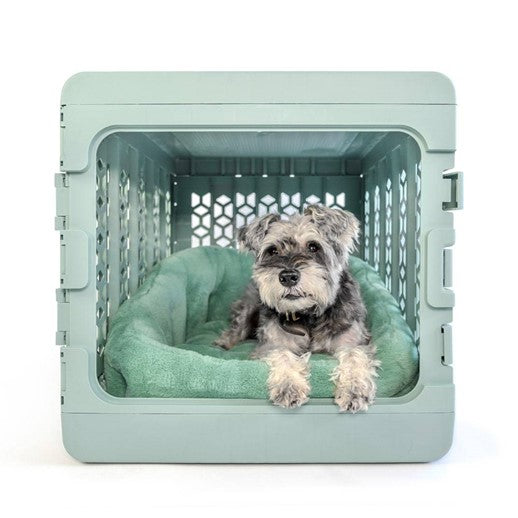GET 15% OFF WITH THE PUPPY BUNDLE
GET 15% OFF WITH THE PUPPY BUNDLE
Shop all

Tips on Teaching Your Dog to Love Their Crate
July 16, 2024 3 min read
Imagine a scenario where every time you mention "crate time," your dog wags its tail and rushes in without hesitation. This scenario is entirely possible with the right approach to crate training.
Crates are not just a safety measure for traveling or managing your home; they can also serve as a cozy retreat for your furry friend. At KindTail, we offer a variety of products, including portable dog crates and luxurious dog crate beds designed to ensure comfort and ease for your pet. Let’s explore how positive reinforcement can transform a crate into a beloved safe haven for your dog.
Understanding the Basics of Crate Training
Crate training is beneficial for numerous reasons. It provides your dog with a personal space where they can retreat and relax, ensures their safety during travels, and assists in house training by tapping into a dog's natural reluctance to soil their sleeping area.
Selecting the right crate is the first step—choose a size that allows your dog to stand up, turn around, and lie down comfortably without being too spacious. A collapsible dog crate is ideal for homeowners who value flexibility and storage, and perfect for those who travel often with their pets.
Setting Up a Welcoming Space
Choosing the Right Location
The placement of the crate within your home can significantly affect how your dog perceives it. Choose a location that is quiet enough to offer solitude but still allows your pet to feel part of the family activities. Avoid placing the crate in direct sunlight or drafty areas.
Creating Comfort Inside the Crate
A bare crate can seem uninviting, so it's crucial to make it appealing. Start by adding a comfy dog bed that fits well within the crate to provide a soft, warm place for your dog to rest. KindTail’s dog crate beds are designed for maximum comfort. Including a favorite toy and perhaps an item with your scent (like an old t-shirt) can also help make the crate feel more secure and inviting.
Positive Reinforcement Techniques
Introducing the Crate
Begin by letting your dog explore the crate at their own pace without closing them in. Place treats and favorite toys inside to encourage them to enter. Always keep the door open as a sign that they are not trapped.
Training Sessions
Start with short training sessions. Command your dog to enter the crate using a cheerful tone, and use a specific word or phrase like "crate time." Reward them with treats and praise immediately after they enter. Gradually increase the duration they spend in the crate with the door closed while you are home.
Rewards and Incentives
Consistently use positive reinforcement. Every time your dog goes into the crate, give them a treat, praise, or playtime. This association builds a positive routine around the crate.
Gradual Acclimation to the Crate
Increasing Crate Time
As your dog becomes more comfortable with the crate, start leaving them crated for short periods while you leave the house, gradually increasing the time as they get more accustomed to it.
Dealing with Anxiety
If your dog shows signs of anxiety when crated (like whining or scratching), it’s essential to revert to shorter crating periods and slowly build up their tolerance. Never use the crate as punishment, as this can create negative associations.
Maintaining Good Crate Habits
Routine and Consistency
Dogs thrive on routine. Regular crating hours help your dog understand when it’s time to rest and when it’s time to play, which can significantly reduce anxiety and behavioral issues.
Balancing Crate Time
Ensure your dog has a balanced lifestyle with adequate exercise, social interaction, and crate time. Spending too much time in a crate can lead to depression and anxiety, so balance is key.
Teaching your dog to love their crate is not just about convenience—it's about creating a secure, happy environment for your pet. With the right approach and tools from KindTail, such as our dog training crates and comfy beds, you can help your dog embrace their crate as a safe haven.
By following these steps and consistently applying positive reinforcement, your dog will start to view their crate as a personal haven rather than a place of confinement, paving the way for a happier, more secure pet.





